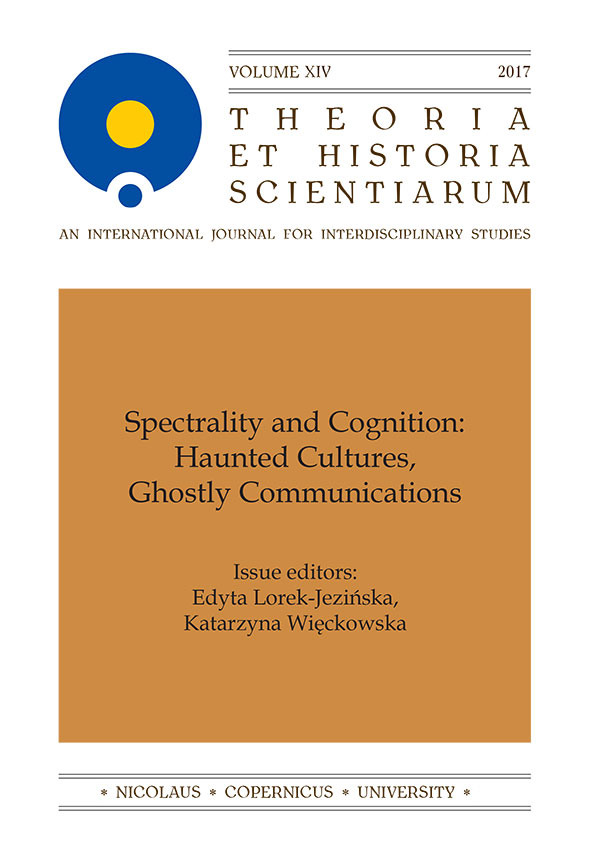Chuck Palahniuk’s Haunted: A Novel of Stories and the Underbellies of American Culture
DOI:
https://doi.org/10.12775/ths.2017.007Keywords
Palahniuk, Haunted, horror, abject, metafctionAbstract
Chuck Palahniuk’s Haunted is a novel made of stories but also a novel about the tradition of telling stories, particularly those meant to evoke terror and shock, as well as related pleasures. Here, twenty-three tales told by writers trapped in an abandoned theatre flesh out the frame narrative whose key takes the form of the “Nightmare Box,” a mysterious apparatus allowing a glimpse into the indescribable (or “the real reality”). The readers, too, are allowed a peek into the nightmare box that the setting of the novel transforms into as its inhabitants, observed and recorded by a Mr. Whittier, the owner of the original device and the mastermind behind the plot, turn to murder, cannibalism and self-mutilation to enhance the effect that the story of their survival will have upon its (and their) release. This article examines the rhetoric of the unclean in the novel with the use of Julia Kristeva’s category of the abject and it rereads Haunted as both an addition to and a commentary on the canon of works which capitalize on haunted spaces, fragmented bodies and the illusory nature of the lived reality.References
Beville, M. (2009). Gothic-postmodernism: Voicing the Terrors of Postmodernity. Amsterdam and New York: Rodopi.
Buffa, D. (2009). “Teacher Suspended for Giving ‘Self-pleasure’ Reading to Students.” New York Post (9 November 2009). http://nypost.com/2009/11/09/teacher-suspended-for-giving-self-pleasure-reading-to-students/, 11.07.2017.
Fiedler, L. A. (1966). Love and Death in the American Novel. New York: Stein and Day.
Gilman, Ch. P. (2008). “The Yellow Wallpaper.” Electronic edition by Project Gutenberg,. n. pag. 01.05.2017.
Hawthorne, N. (2008). The House of the Seven Gables. Electronic edition by Project Gutenberg,. n. pag. 01.05.2017.
Hurley, K. (2004). The Gothic Body: Sexuality Materialism and Degeneration at the fn-de-siècle. Cambridge, MA: Cambridge University Press.
Jackson, S. (2009). The Haunting of Hill House. London: Penguin Classics.
Kristeva, J. (1982). Powers of Horror: An Essay on Abjection. Trans. Leon S. Roudiez. New York: Columbia University Press.
Kuhn, C. and Rubin L. (2009). “Introduction.” In: C. Kuhn and L. Rubin, eds. Reading Chuck Palahniuk: American Monsters and Literary Mayhem. New York: Routledge.
Lloyd-Smith, A. (1996). “Postmodernism/Gothicism.” In: V. Sage and A. LloydSmith, eds. Modern Gothic: A Reader. Manchester and New York: Manchester University Press. 6–20.
Martin, R. K. and Savoy, E., eds. (1998). American Gothic: New Interventions in a National Narrative. Iowa City: University of Iowa Press.
Palahniuk, Ch. (2006). Haunted: A Novel of Stories. New York: Vintage.
Palahniuk, Ch. (2004). “Guts.” Playboy Magazine. March (51).
Punter, D. and Byron, G., eds. (2004). The Gothic. Oxford: Blackwell Publishing.
Savoy, E. (2002). “The Rise of American Gothic.” In: J. E. Hogle, ed. The Cambridge Companion to Gothic Fiction. Cambridge: Cambridge University Press. 167–188.
Sonser, A. (2001). A Passion for Consumption: The Gothic Novel in America. Bowling Green, OH: Bowling Green State University Press.
Downloads
Published
How to Cite
Issue
Section
Stats
Number of views and downloads: 1772
Number of citations: 0



